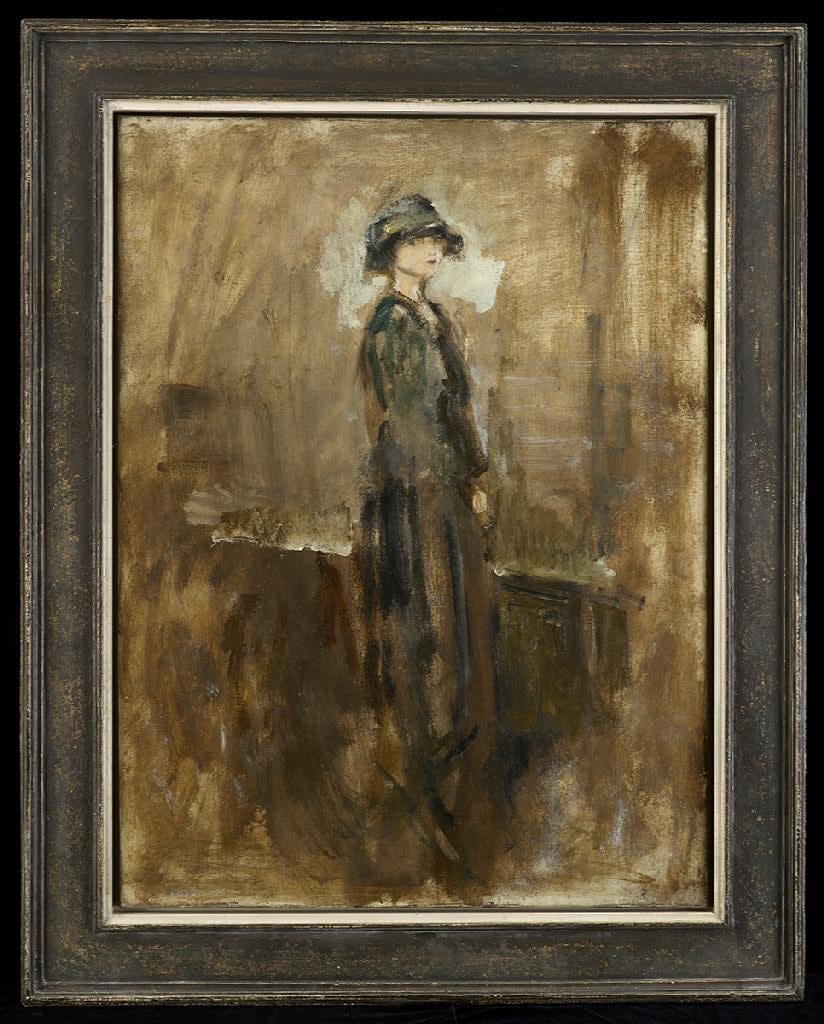
Ambrose McEvoy
Lady in a hat, c. 1915-20
Oil on canvas
40 x 29 ½ in (102 x 74.5 cm)
Philip Mould & Co.
To view all current artworks for sale visit philipmould.com This arresting and subtle oil study by the premier society portraitist, Ambrose McEvoy, fuses currents in both English and Continental...
To view all current artworks for sale visit philipmould.com
This arresting and subtle oil study by the premier society portraitist, Ambrose McEvoy, fuses currents in both English and Continental painting to produce a potently whimsical portrayal of 20s glamour combined with thoughtful introspection. The composition, which in painterly technique shows awareness of both Camden Town school painting, most obviously Sickert, as well as French post-impressionism, is one he used for several of his most prestigious works, including his fine full-length of Consuelo, Duchess of Marlborough, painted c.1916. The identity of the subject presently remains unknown, but is clearly a model who engendered the artist’s ambitious artistic responses.
Ambrose McEvoy began his career at the Slade, having been encouraged by his father and his father’s friend James Abbott McNeill Whistler. At the Slade he became close friends with Augustus John, with whom he shared a studio for a time, and embarked on a ‘stormy’ affair with his sister, Gwen. In 1900 Gwen John was deeply hurt at McEvoy’s announcement that he was engaged to Mary Augusta Spencer Edwards, a fellow Slade student. Ambrose McEvoy and Mary Spencer Edwards married in 1902 and in 1906 they moved to 107 Grosvenor Road where they would spend the rest of their lives.
Following his visit to Dieppe with Walter Sickert in 1909, McEvoy’s style of painting evolved. The more sombre-coloured interior and narrative scenes that typified his earlier work soon gave way to a more expressive approach, characterized by the same broad, sweeping strokes seen in the present work. This highly modern style reached its maturity in the 1920s, and some of McEvoys most successful portraits from that date venture beyond the realms of representation and edge daringly closer to abstraction.
Few works of this quality by McEvoy have been on the market in recent years. A portrait described as an unknown lady, purchased by this gallery, sold at Dreweatt Neate February 2015 (£41,216) and was resold into the London art trade. It was of notably smaller dimensions (30 x 25 inches).
This arresting and subtle oil study by the premier society portraitist, Ambrose McEvoy, fuses currents in both English and Continental painting to produce a potently whimsical portrayal of 20s glamour combined with thoughtful introspection. The composition, which in painterly technique shows awareness of both Camden Town school painting, most obviously Sickert, as well as French post-impressionism, is one he used for several of his most prestigious works, including his fine full-length of Consuelo, Duchess of Marlborough, painted c.1916. The identity of the subject presently remains unknown, but is clearly a model who engendered the artist’s ambitious artistic responses.
Ambrose McEvoy began his career at the Slade, having been encouraged by his father and his father’s friend James Abbott McNeill Whistler. At the Slade he became close friends with Augustus John, with whom he shared a studio for a time, and embarked on a ‘stormy’ affair with his sister, Gwen. In 1900 Gwen John was deeply hurt at McEvoy’s announcement that he was engaged to Mary Augusta Spencer Edwards, a fellow Slade student. Ambrose McEvoy and Mary Spencer Edwards married in 1902 and in 1906 they moved to 107 Grosvenor Road where they would spend the rest of their lives.
Following his visit to Dieppe with Walter Sickert in 1909, McEvoy’s style of painting evolved. The more sombre-coloured interior and narrative scenes that typified his earlier work soon gave way to a more expressive approach, characterized by the same broad, sweeping strokes seen in the present work. This highly modern style reached its maturity in the 1920s, and some of McEvoys most successful portraits from that date venture beyond the realms of representation and edge daringly closer to abstraction.
Few works of this quality by McEvoy have been on the market in recent years. A portrait described as an unknown lady, purchased by this gallery, sold at Dreweatt Neate February 2015 (£41,216) and was resold into the London art trade. It was of notably smaller dimensions (30 x 25 inches).
Provenance
The artist’s estate.Be the first to hear about our available artworks
* denotes required fields
We will process the personal data you have supplied in accordance with our privacy policy (available on request). You can unsubscribe or change your preferences at any time by clicking the link in our emails.